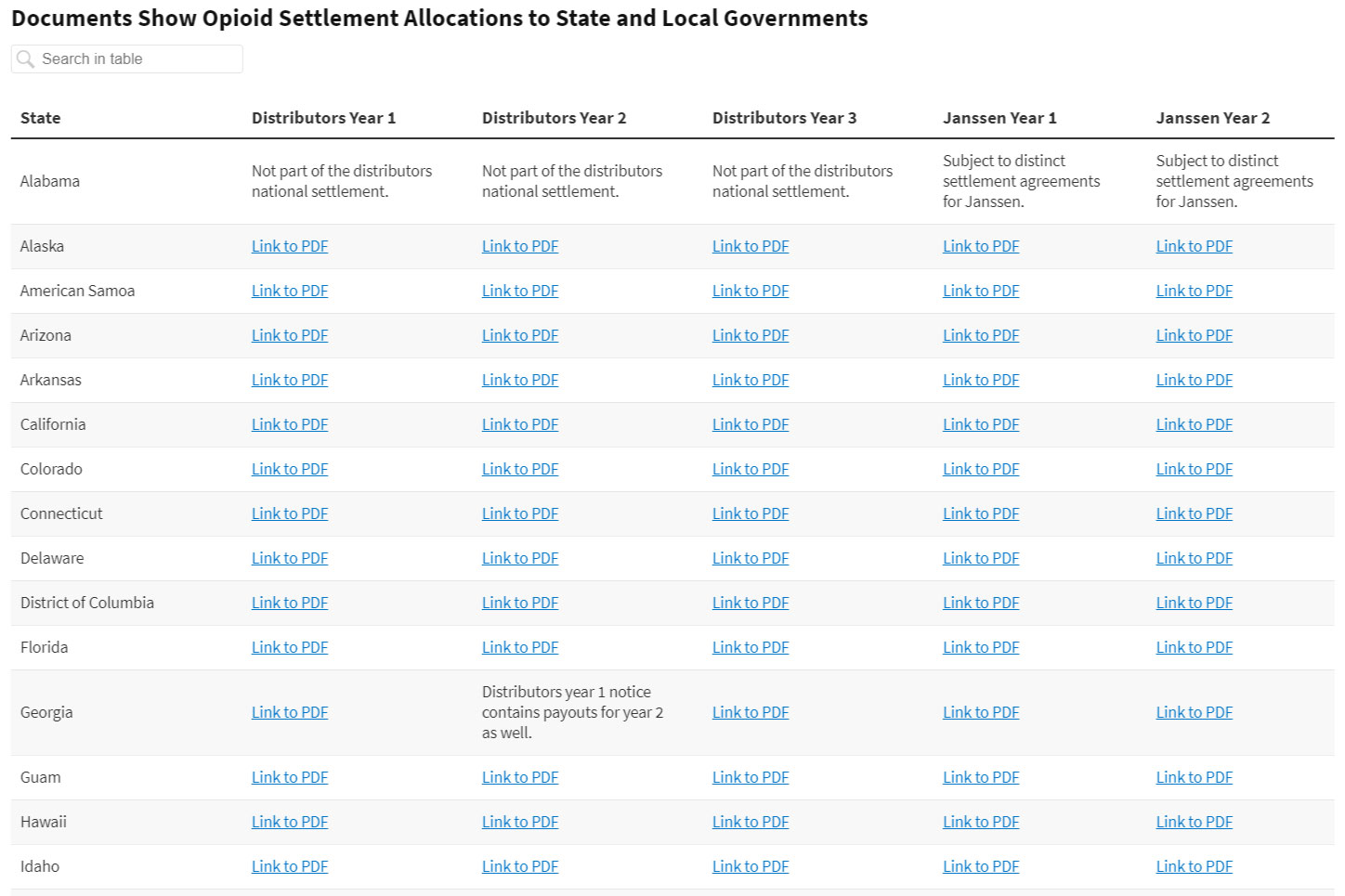Thousands of local governments nationwide are receiving settlement money from companies that made, sold, or distributed opioid painkillers, like Johnson & Johnson, AmerisourceBergen, and Walmart. The companies are shelling out more than $50 billion total in settlements from national lawsuits. But finding out the precise amount each city or county is receiving has been nearly impossible because the firm administering the settlement hasn’t made the information public.
Until now.
After more than a month of communications with state attorneys general, private lawyers working on the settlement, and the settlement administrators, KFF Health News has obtained documents showing the exact dollar amounts — down to the cent — that local governments were allocated for 2022 and 2023. More than 200 spreadsheets detail the amounts paid by four of the companies involved in national settlements. (Several other opioid-related companies will start making payments later this year.)
For example, Jefferson County, Kentucky — home to Louisville — received $860,657.73 from three pharmaceutical distributors this year, while Knox County, a rural Kentucky county in Appalachia — the region many consider ground zero of the crisis — received $45,395.33.
In California, Los Angeles County was allocated $6.3 million from Janssen, the pharmaceutical subsidiary of Johnson & Johnson, this year. Mendocino County, which has one of the highest opioid overdose death rates in the state, was allocated about $185,000.
Access to “this information is revolutionary for people who care about how this money will be used,” said Dennis Cauchon, president of the nonprofit advocacy group Harm Reduction Ohio.
Some states, like North Carolina and Colorado, have posted their distribution specifics online. But in most other places, tracking payment amounts requires people to make phone calls, send emails, and file public records requests with every local government for which they want the information.
Thus, gathering the data across one state could mean contacting hundreds of places. For the country, that could translate to thousands.
Cauchon has been seeking this information for his state since April 2022. “Opioid remediation work is done at the local level, at the individual level, and, now, for the first time, local people working on the issues will know how much money is available in their community.”
The national opioid settlements are the second-largest public health settlement of all time, following the tobacco master settlement of the 1990s. The money is meant as remediation for the way corporations aggressively promoted opioid painkillers, fueling an overdose crisis that has now largely transitioned to illicit drugs, like fentanyl. More than 105,000 Americans died of drug overdoses last year.
So far, state and local governments have received more than $3 billion combined, according to a national summary document created by BrownGreer, a settlement administration and litigation management firm that was court-appointed to handle the distribution of payments. In each state, settlement funds are divided in varying percentages among state agencies, local governments, and, in some cases, councils that oversee opioid abatement trusts. Payments began in 2022 and will continue through 2038, setting up what public health experts and advocates are calling an unprecedented opportunity to make progress against an epidemic that has ravaged America for three decades. KFF Health News is tracking how governments use — and misuse — this cash in a yearlong investigation.
The latest trove of documents was obtained from BrownGreer. The firm is one of the few entities that knows exactly how much money each state and local government receives and when, since it oversees complex calculations involving the varying terms and timelines of each company’s settlement.
Even so, there are gaps in the information it shared. A handful of states opted not to receive their payments via BrownGreer. Some directed the firm to pay a lump sum to the state, which would then distribute it to local governments. In those cases, BrownGreer did not have figures for local allocations. A few states that settled with the opioid-related companies separately from the national deals are not part of BrownGreer’s data, either.
Roma Petkauskas, a partner at BrownGreer, said the settlement agreement requires the firm to send notices of payment amounts to state and local governments, as well as to the companies that settled. It shared documents when KFF Health News asked, but it is not clear if the firm will continue doing so.
Petkauskas wrote, “Settlement Agreements do not provide that such notices be made public,” indicating such disclosure was not a requirement.
People harmed by the opioid crisis say they want more transparency than the bare minimum requirements. They say, currently, it’s not only difficult to determine how much money governments receive, but also how those dollars are spent. Many people have reached out to local officials with questions or suggestions only to be turned away or ignored.
Christine Minhee, founder of OpioidSettlementTracker.com, found that, as of March, only 12 states had committed to publicly reporting the use of 100% of their settlement dollars. Since then, just three more states have promised to share detailed information on their use of the money.
Loading…
Legal and political experts watching the settlements say the lack of transparency may have to do with political leverage. State attorneys general have touted these deals as achievements in glowing press releases.
“Attorney General [Daniel] Cameron today delivered on his promise to fight back against the opioid epidemic by announcing a more than $53 million agreement with Walmart,” read one press release issued late last year by the state of Kentucky.
“Thousands of our neighbors have buried their loved ones throughout the opioid epidemic” and “I am proud to have delivered this great agreement to them,” said Louisiana Attorney General Jeff Landry, in a July 2021 announcement when one of the earliest settlements was finalized.
Greater transparency, including the specific payment amounts for each local government, may take the wind out of some of those press releases, Minhee said. “It’s hard to politicize things when you can’t present the numbers in a vacuum.”
If one community compares its several-hundred-dollar payout to another community’s multi-thousand-dollar payout, there may be political fallout. Concerns have already arisen in rural areas hit hard by the crisis that the distribution formula weighs population numbers too heavily, and they will not receive enough money to address decades of harm.
Still, experts say making this data public is a crucial step in ensuring the settlements fulfill the goal of saving lives and remediating this crisis.
Solutions have to be community-led, said Regina LaBelle, director of the addiction and public policy initiative at Georgetown University’s O’Neill Institute. “In order to do that, the communities themselves need to know how much money they’re getting.”
If their county is receiving $5,000 this year, it wouldn’t make sense to advocate for a $500,000 detox facility. Instead, they might focus on purchasing naloxone, a medication that reverses opioid overdoses. Knowing the yearly amount also allows people to track the funds and ensure they’re not being misspent, LaBelle added.
For Cauchon, of Harm Reduction Ohio, the local-level payment data is key to ensuring settlement dollars are put to good use in each Ohio county.
“Knowledge is power and, in this case, it’s the power to know how much money is available to be used to prevent overdoses,” he said.








